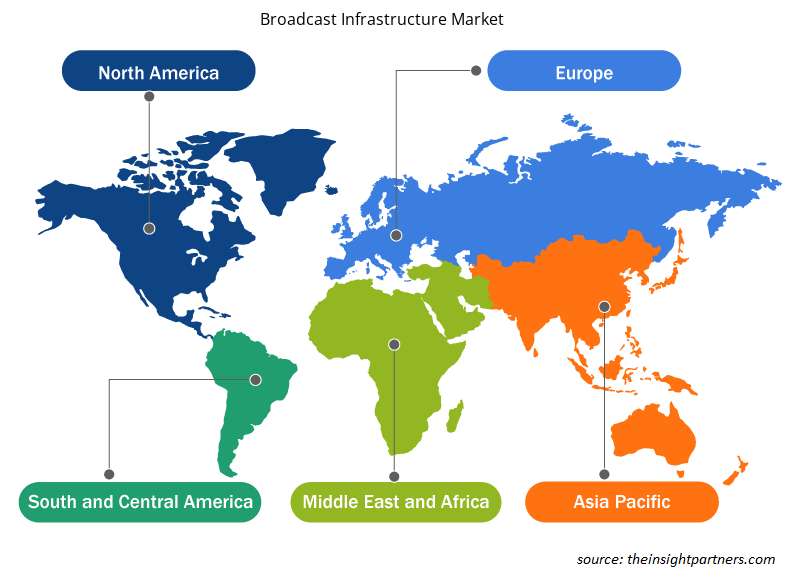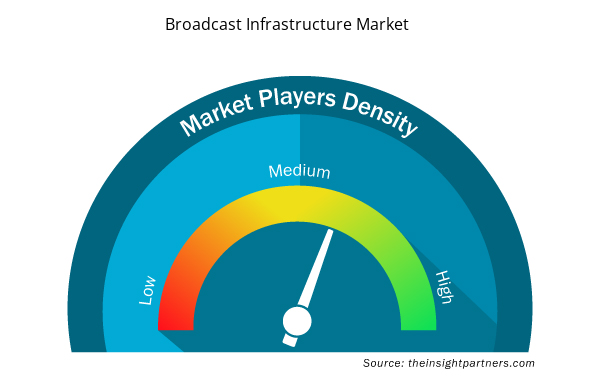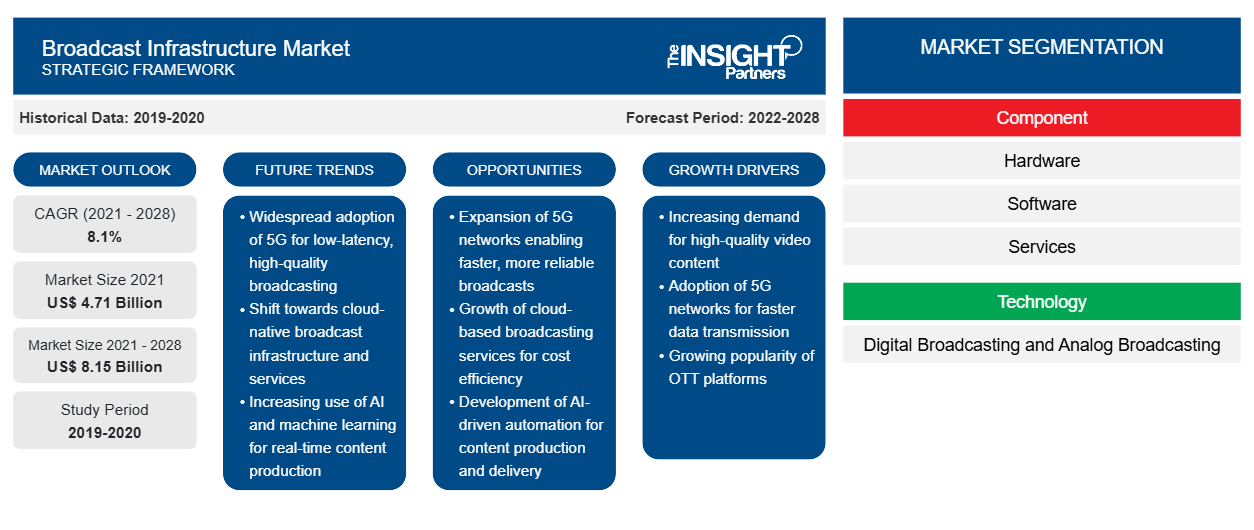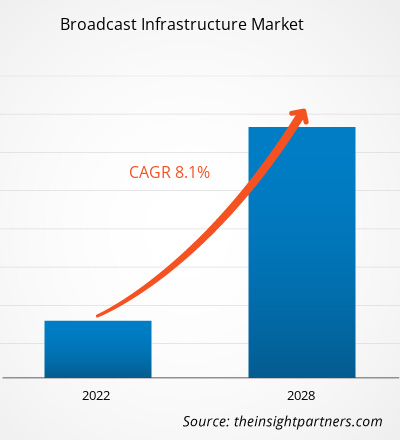[Rapporto di ricerca] Il mercato delle infrastrutture di trasmissione è stato valutato a 4.713,7 milioni di dollari nel 2021 e si prevede che raggiungerà gli 8.145,7 milioni di dollari entro il 2028; si prevede che crescerà a un CAGR dell'8,1% dal 2021 al 2028.
Il cambiamento di paradigma del settore della trasmissione dalla tecnologia analogica a quella digitale ha introdotto un'infrastruttura di trasmissione avanzata, relativamente complessa. Il settore della trasmissione sta assistendo a una domanda significativa di nuove tecnologie di trasmissione come la televisione tramite protocollo Internet (IPTV), la TV Web, la televisione ad alta definizione (HDTV) e il pay-per-view. Si prevede che la domanda di esperienze video arricchite aprirà la strada alle emittenti in tutto il mondo, soprattutto in Asia. Un altro fattore chiave che guida il mercato delle infrastrutture di trasmissione sono le piattaforme integrate costituite da server, decoder e sistemi di protezione dei contenuti video, insieme a strumenti, middleware e fatturazione appropriati, che consentono la fornitura di una varietà di servizi TV in diversi formati, come video-on-demand, streaming e TV time-shifted, basati su una combinazione di reti IP sottostanti e sistemi di accesso DSL o ottici. Oggigiorno, i fornitori stanno passando da un'infrastruttura basata su hardware a un'infrastruttura basata su software a causa dell'elevato costo dell'infrastruttura hardware di trasmissione, degli elevati costi di manutenzione e dei frequenti aggiornamenti hardware. Il settore della radiodiffusione ha vissuto innovazioni rivoluzionarie con sviluppi tecnologici volti a fornire un'esperienza migliore agli utenti e a creare opportunità per i fornitori di infrastrutture di trasmissione.
Personalizza questo report in base alle tue esigenze
Riceverai la personalizzazione gratuita di qualsiasi report, comprese parti di questo report, o analisi a livello nazionale, pacchetto dati Excel, oltre a usufruire di grandi offerte e sconti per start-up e università
- Scopri le principali tendenze di mercato in questo rapporto.Questo campione GRATUITO includerà analisi di dati che spaziano dalle tendenze di mercato alle stime e alle previsioni.
Impatto della pandemia di COVID-19 sul mercato delle infrastrutture di trasmissione
Nella pandemia di COVID-19 un numero enorme di persone lavora da casa e trascorre più tempo online, vantando il passaggio al digitale. Questa richiesta di risorse digitali sta ulteriormente stressando i sistemi di diverse organizzazioni di software e piattaforme e ostacolando la loro capacità di fornire servizi con affidabilità e qualità. Tuttavia, lo scoppio del COVID-19 ha avuto un impatto negativo sugli attori coinvolti nella distribuzione di contenuti video per gli utenti finali, a causa della chiusura delle attività e della scarsità di manodopera. La crisi del COVID-19 ha anche drasticamente stravolto le operazioni lungo tutta la catena del valore, dalle reti di fornitori all'esperienza di consegna al cliente a causa di blocchi aziendali, divieti di viaggio e interruzioni della catena di fornitura.lockdowns, travel bans, and supply chain disruptions.
Approfondimenti di mercato – Mercato delle infrastrutture di trasmissione
Crescente adozione di nuove tecnologie di trasmissione
Con il continuo miglioramento della digitalizzazione e un aumento del reddito disponibile, il mercato sta assistendo a un alto tasso di adozione di IPTV e HDTV. Si prevede che la domanda di esperienze video arricchite aprirà la strada alle emittenti in tutto il mondo, soprattutto in Asia. La proliferazione della banda larga sta aumentando in tutta l'APAC, a causa della visione on-demand dei consumatori. Inoltre, le piattaforme over-the-top (OTT) basate su abbonamento come Netflix stanno guadagnando terreno in Asia. Si prevede che l'aumento della spesa pubblica per infrastrutture basate su cloud, soluzioni basate su cloud e servizi gestiti e reti ibride stimolerà la crescita del mercato delle infrastrutture di trasmissione. Le crescenti preoccupazioni per la sicurezza e il mantenimento della fiducia dei clienti incoraggeranno le emittenti ad adottare nuovi modelli di distribuzione. È probabile che tutti i progressi e gli sviluppi abbiano un impatto positivo sulla crescita del mercato durante il periodo di previsione.
Approfondimenti basati sui componenti
In base al componente, il mercato delle infrastrutture di trasmissione è segmentato in hardware, software e servizi. Il segmento software ha detenuto la quota di mercato maggiore nel 2020.
Approfondimenti regionali sul mercato delle infrastrutture di trasmissione
Le tendenze regionali e i fattori che influenzano il Broadcast Infrastructure Market durante il periodo di previsione sono stati ampiamente spiegati dagli analisti di Insight Partners. Questa sezione discute anche i segmenti e la geografia del Broadcast Infrastructure Market in Nord America, Europa, Asia Pacifico, Medio Oriente e Africa e Sud e Centro America.

- Ottieni i dati specifici regionali per il mercato delle infrastrutture di trasmissione
Ambito del rapporto sul mercato delle infrastrutture di trasmissione
| Attributo del report | Dettagli |
|---|---|
| Dimensioni del mercato nel 2021 | 4,71 miliardi di dollari USA |
| Dimensioni del mercato entro il 2028 | 8,15 miliardi di dollari USA |
| CAGR globale (2021 - 2028) | 8,1% |
| Dati storici | 2019-2020 |
| Periodo di previsione | 2022-2028 |
| Segmenti coperti | Per componente
|
| Regioni e Paesi coperti | America del Nord
|
| Leader di mercato e profili aziendali chiave |
|
Densità degli attori del mercato: comprendere il suo impatto sulle dinamiche aziendali
Il mercato Broadcast Infrastructure Market sta crescendo rapidamente, spinto dalla crescente domanda degli utenti finali dovuta a fattori quali l'evoluzione delle preferenze dei consumatori, i progressi tecnologici e una maggiore consapevolezza dei vantaggi del prodotto. Con l'aumento della domanda, le aziende stanno ampliando le loro offerte, innovando per soddisfare le esigenze dei consumatori e capitalizzando sulle tendenze emergenti, il che alimenta ulteriormente la crescita del mercato.
La densità degli operatori di mercato si riferisce alla distribuzione di aziende o società che operano in un particolare mercato o settore. Indica quanti concorrenti (operatori di mercato) sono presenti in un dato spazio di mercato in relazione alle sue dimensioni o al valore di mercato totale.
Le principali aziende che operano nel mercato delle infrastrutture di trasmissione sono:
- Cisco Systems, Inc.
- Tecnologia di trasmissione Clyde
- Sistemi informatici CS Ltd.
- Società a responsabilità limitata
- Attrezzature per trasmissioni EVS SA
Disclaimer : le aziende elencate sopra non sono classificate secondo un ordine particolare.

- Ottieni una panoramica dei principali attori del mercato delle infrastrutture di trasmissione
Gli operatori che operano nel mercato delle infrastrutture di trasmissione si concentrano principalmente sullo sviluppo di prodotti avanzati ed efficienti.
- A giugno 2021, EVS, fornitore leader di tecnologia video in diretta per produzioni broadcast e di nuovi media, ha annunciato la sua partnership con Gravity Media per la fornitura del sistema di revisione multi-camera Xeebra come tecnologia di base per la nuova soluzione integrata di comunicazione e aggiudicazione video dell'azienda.
- A giugno 2021, Ross Video ha annunciato l'acquisizione di Primestream, un'azienda di soluzioni per flussi di lavoro Media-Asset. Queste soluzioni sono utilizzate dai clienti in vari settori verticali di mercato, tra cui enterprise, digital media, sport e broadcast. Le loro soluzioni sono progettate per risolvere le sfide creative, aziendali e tecnologiche uniche e sempre più complesse in ogni mercato. Attraverso questa acquisizione, Ross cercherà naturalmente di fondere la sua soluzione di gestione delle risorse multimediali Streamline con i prodotti Primestream nel tempo, per creare una piattaforma di gestione delle risorse grafiche e di produzione completamente convergente.
Il mercato delle infrastrutture di trasmissione è stato segmentato come segue:
Mercato delle infrastrutture di trasmissione – per componente
- Hardware
- Software
- Servizi
Mercato delle infrastrutture di trasmissione – per tecnologia
- Trasmissione digitale
- Trasmissione analogica
Mercato delle infrastrutture di trasmissione – per applicazione
- Ottimo
- Terrestre
- Satellitare
- Televisore IPTV
- Altri
Mercato delle infrastrutture di trasmissione – per area geografica
- America del Nord
- NOI
- Canada
- Messico
- Europa
- Germania
- Francia
- Italia
- Regno Unito
- Russia
- Resto d'Europa
- Asia Pacifico (APAC)
- Australia
- Cina
- India
- Giappone
- Corea del Sud
- Resto dell'APAC
- Medio Oriente e Africa (MEA)
- Arabia Saudita
- Emirati Arabi Uniti
- Sudafrica
- Resto del MEA
- America del Sud (SAM)
- Brasile
- Argentina
- Resto del SAM
Mercato delle infrastrutture di trasmissione – Profili aziendali
- Cisco Systems, Inc.
- Tecnologia di trasmissione Clyde
- Sistemi informatici CS Ltd.
- Società a responsabilità limitata
- Attrezzature per trasmissioni EVS SA
- Valle dell'erba
- Calura
- Nevio
- Ross Video Ltd
- Zixi
- Analisi storica (2 anni), anno base, previsione (7 anni) con CAGR
- Analisi PEST e SWOT
- Valore/volume delle dimensioni del mercato - Globale, regionale, nazionale
- Industria e panorama competitivo
- Set di dati Excel



Report Coverage
Revenue forecast, Company Analysis, Industry landscape, Growth factors, and Trends

Segment Covered
This text is related
to segments covered.

Regional Scope
North America, Europe, Asia Pacific, Middle East & Africa, South & Central America

Country Scope
This text is related
to country scope.
Domande frequenti
US led the broadcast infrastructure market globally with a market share of 68.7% in the year 2020. For instance, For instance in 2021, DigitalBridge Group, an American made an announcement to acquire a majority stake in Vertical Bridge, the largest operator of wireless communications infrastructure in the US with an aim to meet the rising demands for broadcast infrastructure solutions. Significant investments in the 5G infrastructure by the government of the US has created a tremendous long-term growth opportunities for telecommunications infrastructure in the region.
The major companies in broadcast infrastructure includes Computer System, Grass Valley, EVS Broadcast Equipment, Nevion, Kaltura, among others. The ranking has been derived analysing multiple parameters such as annual revenue earned from broadcast infrastructure portfolio, client base, geographic locations, R&D expenditure, brand image, and number of employees, among others. These companies are actively participating in developing broadcast infrastructure for various applications.
The broadcast infrastructures have been in use for several years worldwide, however, the technology has been experiencing immense demand in recent years. The noteworthy increasing adoption of new broadcast technologies and migration from hardware to software based infrastructure is supporting the growth of broadcast infrastructure market. Moreover, the demand for cloud-based solutions in the broadcast industry for low cost and high scalability increases, the opportunities for market players who provide cost-effective and efficient streaming will propel the growth of the market.
In 2020, North America led the market with a substantial revenue share, followed by Europe, and APAC. Asia Pacific is a prospective market for broadcast infrastructure market players.
Increasing demand of Digital Terrestrial TV (DTTV) is the key opportunity for the broadcast infrastructure market. Growing demand of smart TVs, and advancements in telecom and broadcast industry is anticipated to drive the growth of Digital Terrestrial Television (DTT). With increasing consumption of TV sets and expenditure on terrestrial networks for quality, entertainment, and family friendly purpose, the demand for DTT has boosted.
The global broadcast infrastructure market was dominated by terrestrial segment with market share of 44% in 2020. Terrestrial television refers to methods of television broadcasting which do not include satellite transmission or through underground cables. The transition to digital terrestrial TV from analog terrestrial TV can be considered a significant development for the broadcasting industry. While the implementation of digital broadcasting has been led by satellite, cable, and to some extent IPTV, it is the evolution of the terrestrial broadcast platform that perhaps brings most benefits to the society.
Trends and growth analysis reports related to Electronics and Semiconductor : READ MORE..
The List of Companies - Broadcast Infrastructure Market
- Cisco Systems, Inc.
- Clyde Broadcast Technology
- CS Computer Systems Ltd.
- Dacast Inc.
- EVS Broadcast Equipment SA
- Grass Valley
- Kaltura
- Nevion
- Ross Video Ltd
- Zixi
The Insight Partners performs research in 4 major stages: Data Collection & Secondary Research, Primary Research, Data Analysis and Data Triangulation & Final Review.
- Data Collection and Secondary Research:
As a market research and consulting firm operating from a decade, we have published and advised several client across the globe. First step for any study will start with an assessment of currently available data and insights from existing reports. Further, historical and current market information is collected from Investor Presentations, Annual Reports, SEC Filings, etc., and other information related to company’s performance and market positioning are gathered from Paid Databases (Factiva, Hoovers, and Reuters) and various other publications available in public domain.
Several associations trade associates, technical forums, institutes, societies and organization are accessed to gain technical as well as market related insights through their publications such as research papers, blogs and press releases related to the studies are referred to get cues about the market. Further, white papers, journals, magazines, and other news articles published in last 3 years are scrutinized and analyzed to understand the current market trends.
- Primary Research:
The primarily interview analysis comprise of data obtained from industry participants interview and answers to survey questions gathered by in-house primary team.
For primary research, interviews are conducted with industry experts/CEOs/Marketing Managers/VPs/Subject Matter Experts from both demand and supply side to get a 360-degree view of the market. The primary team conducts several interviews based on the complexity of the markets to understand the various market trends and dynamics which makes research more credible and precise.
A typical research interview fulfils the following functions:
- Provides first-hand information on the market size, market trends, growth trends, competitive landscape, and outlook
- Validates and strengthens in-house secondary research findings
- Develops the analysis team’s expertise and market understanding
Primary research involves email interactions and telephone interviews for each market, category, segment, and sub-segment across geographies. The participants who typically take part in such a process include, but are not limited to:
- Industry participants: VPs, business development managers, market intelligence managers and national sales managers
- Outside experts: Valuation experts, research analysts and key opinion leaders specializing in the electronics and semiconductor industry.
Below is the breakup of our primary respondents by company, designation, and region:

Once we receive the confirmation from primary research sources or primary respondents, we finalize the base year market estimation and forecast the data as per the macroeconomic and microeconomic factors assessed during data collection.
- Data Analysis:
Once data is validated through both secondary as well as primary respondents, we finalize the market estimations by hypothesis formulation and factor analysis at regional and country level.
- Macro-Economic Factor Analysis:
We analyse macroeconomic indicators such the gross domestic product (GDP), increase in the demand for goods and services across industries, technological advancement, regional economic growth, governmental policies, the influence of COVID-19, PEST analysis, and other aspects. This analysis aids in setting benchmarks for various nations/regions and approximating market splits. Additionally, the general trend of the aforementioned components aid in determining the market's development possibilities.
- Country Level Data:
Various factors that are especially aligned to the country are taken into account to determine the market size for a certain area and country, including the presence of vendors, such as headquarters and offices, the country's GDP, demand patterns, and industry growth. To comprehend the market dynamics for the nation, a number of growth variables, inhibitors, application areas, and current market trends are researched. The aforementioned elements aid in determining the country's overall market's growth potential.
- Company Profile:
The “Table of Contents” is formulated by listing and analyzing more than 25 - 30 companies operating in the market ecosystem across geographies. However, we profile only 10 companies as a standard practice in our syndicate reports. These 10 companies comprise leading, emerging, and regional players. Nonetheless, our analysis is not restricted to the 10 listed companies, we also analyze other companies present in the market to develop a holistic view and understand the prevailing trends. The “Company Profiles” section in the report covers key facts, business description, products & services, financial information, SWOT analysis, and key developments. The financial information presented is extracted from the annual reports and official documents of the publicly listed companies. Upon collecting the information for the sections of respective companies, we verify them via various primary sources and then compile the data in respective company profiles. The company level information helps us in deriving the base number as well as in forecasting the market size.
- Developing Base Number:
Aggregation of sales statistics (2020-2022) and macro-economic factor, and other secondary and primary research insights are utilized to arrive at base number and related market shares for 2022. The data gaps are identified in this step and relevant market data is analyzed, collected from paid primary interviews or databases. On finalizing the base year market size, forecasts are developed on the basis of macro-economic, industry and market growth factors and company level analysis.
- Data Triangulation and Final Review:
The market findings and base year market size calculations are validated from supply as well as demand side. Demand side validations are based on macro-economic factor analysis and benchmarks for respective regions and countries. In case of supply side validations, revenues of major companies are estimated (in case not available) based on industry benchmark, approximate number of employees, product portfolio, and primary interviews revenues are gathered. Further revenue from target product/service segment is assessed to avoid overshooting of market statistics. In case of heavy deviations between supply and demand side values, all thes steps are repeated to achieve synchronization.
We follow an iterative model, wherein we share our research findings with Subject Matter Experts (SME’s) and Key Opinion Leaders (KOLs) until consensus view of the market is not formulated – this model negates any drastic deviation in the opinions of experts. Only validated and universally acceptable research findings are quoted in our reports.
We have important check points that we use to validate our research findings – which we call – data triangulation, where we validate the information, we generate from secondary sources with primary interviews and then we re-validate with our internal data bases and Subject matter experts. This comprehensive model enables us to deliver high quality, reliable data in shortest possible time.


 Ottieni un campione gratuito per questo repot
Ottieni un campione gratuito per questo repot